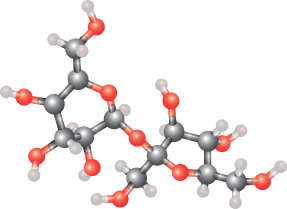


Adisaccharide (also called a double sugarorbiose)[1] is the sugar formed when two monosaccharides are joined by glycosidic linkage.[2] Like monosaccharides, disaccharides are simple sugars soluble in water. Three common examples are sucrose, lactose, and maltose.
Disaccharides are one of the four chemical groupings of carbohydrates (monosaccharides, disaccharides, oligosaccharides, and polysaccharides). The most common types of disaccharides—sucrose, lactose, and maltose—have 12 carbon atoms, with the general formula C12H22O11. The differences in these disaccharides are due to atomic arrangements within the molecule.[3]
The joining of monosaccharides into a double sugar happens by a condensation reaction, which involves the elimination of a water molecule from the functional groups only. Breaking apart a double sugar into its two monosaccharides is accomplished by hydrolysis with the help of a type of enzyme called a disaccharidase. As building the larger sugar ejects a water molecule, breaking it down consumes a water molecule. These reactions are vital in metabolism. Each disaccharide is broken down with the help of a corresponding disaccharidase (sucrase, lactase, and maltase).
There are two functionally different classes of disaccharides:
The formation of a disaccharide molecule from two monosaccharide molecules proceeds by displacing a hydroxy group from one molecule and a hydrogen nucleus (aproton) from the other, so that the new vacant bonds on the monosaccharides join the two monomers together. Because of the removal of the water molecule from the product, the term of convenience for such a process is "dehydration reaction" (also "condensation reaction" or "dehydration synthesis"). For example, milk sugar (lactose) is a disaccharide made by condensation of one molecule of each of the monosaccharides glucose and galactose, whereas the disaccharide sucrose in sugar cane and sugar beet, is a condensation product of glucose and fructose. Maltose, another common disaccharide, is condensed from two glucose molecules.[7]
The dehydration reaction that bonds monosaccharides into disaccharides (and also bonds monosaccharides into more complex polysaccharides) forms what are called glycosidic bonds.[8]
This section does not cite any sources. Please help improve this sectionbyadding citations to reliable sources. Unsourced material may be challenged and removed. (March 2023) (Learn how and when to remove this message)
|
The glycosidic bond can be formed between any hydroxy group on the component monosaccharide. So, even if both component sugars are the same (e.g., glucose), different bond combinations (regiochemistry) and stereochemistry (alpha-orbeta-) result in disaccharides that are diastereoisomers with different chemical and physical properties. Depending on the monosaccharide constituents, disaccharides are sometimes crystalline, sometimes water-soluble, and sometimes sweet-tasting and sticky-feeling. Disaccharides can serve as functional groups by forming glycosidic bonds with other organic compounds, forming glycosides.
Digestion of disaccharides involves breakdown into monosaccharides.
| Disaccharide | Unit 1 | Unit 2 | Bond |
|---|---|---|---|
| Sucrose (table sugar, cane sugar, beet sugar, or saccharose) | Glucose | Fructose | α(1→2)β |
| Lactose (milk sugar) | Galactose | Glucose | β(1→4) |
| Maltose (malt sugar) | Glucose | Glucose | α(1→4) |
| Trehalose | Glucose | Glucose | α(1→1)α |
| Cellobiose | Glucose | Glucose | β(1→4) |
| Chitobiose | Glucosamine | Glucosamine | β(1→4) |
Maltose, cellobiose, and chitobiose are hydrolysis products of the polysaccharides starch, cellulose, and chitin, respectively.
Less common disaccharides include:[9]
| Disaccharide | Units | Bond |
|---|---|---|
| Kojibiose | Two glucoses | α(1→2)[10] |
| Nigerose | Two glucoses | α(1→3) |
| Isomaltose | Two glucoses | α(1→6) |
| β,β-Trehalose | Two glucoses | β(1→1)β |
| α,β-Trehalose | Two glucoses | α(1→1)β[11] |
| Sophorose | Two glucoses | β(1→2) |
| Laminaribiose | Two glucoses | β(1→3) |
| Gentiobiose | Two glucoses | β(1→6) |
| Trehalulose | One glucose and one fructose | α(1→1) |
| Turanose | One glucose and one fructose | α(1→3) |
| Maltulose | One glucose and one fructose | α(1→4) |
| Leucrose | One glucose and one fructose | α(1→5) |
| Isomaltulose | One glucose and one fructose | α(1→6) |
| Gentiobiulose | One glucose and one fructose | β(1→6) |
| Mannobiose | Two mannoses | Either α(1→2), α(1→3), α(1→4), or α(1→6) |
| Melibiose | One galactose and one glucose | α(1→6) |
| Allolactose | One galactose and one glucose | β(1→6) |
| Melibiulose | One galactose and one fructose | α(1→6) |
| Lactulose | One galactose and one fructose | β(1→4) |
| Rutinose | One rhamnose and one glucose | α(1→6) |
| Rutinulose | One rhamnose and one fructose | β(1→6) |
| Xylobiose | Two xylopyranoses | β(1→4) |
|
Sugar as food commodity
| |||||||
|---|---|---|---|---|---|---|---|
| Chemistry |
| ||||||
| Sources |
| ||||||
| Products |
| ||||||
| Industry |
| ||||||
| History |
| ||||||
| Culture |
| ||||||
| Related |
| ||||||
| Research |
| ||||||
| |||||||
|
Types of carbohydrates
| |||||||||||||||
|---|---|---|---|---|---|---|---|---|---|---|---|---|---|---|---|
| General |
| ||||||||||||||
| Geometry |
| ||||||||||||||
| Monosaccharides |
| ||||||||||||||
| Multiple |
| ||||||||||||||
| |||||||||||||||
| Authority control databases: National |
|
|---|